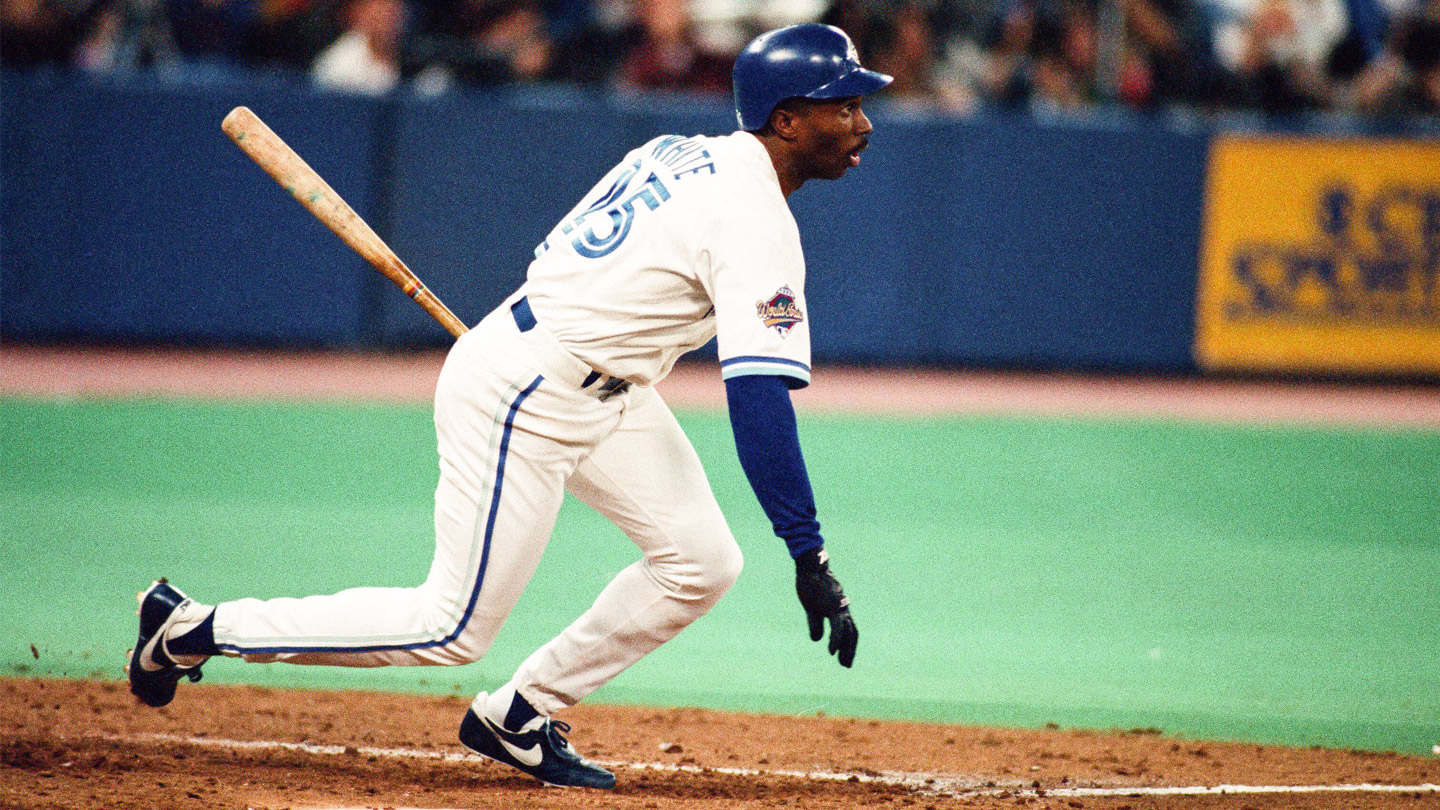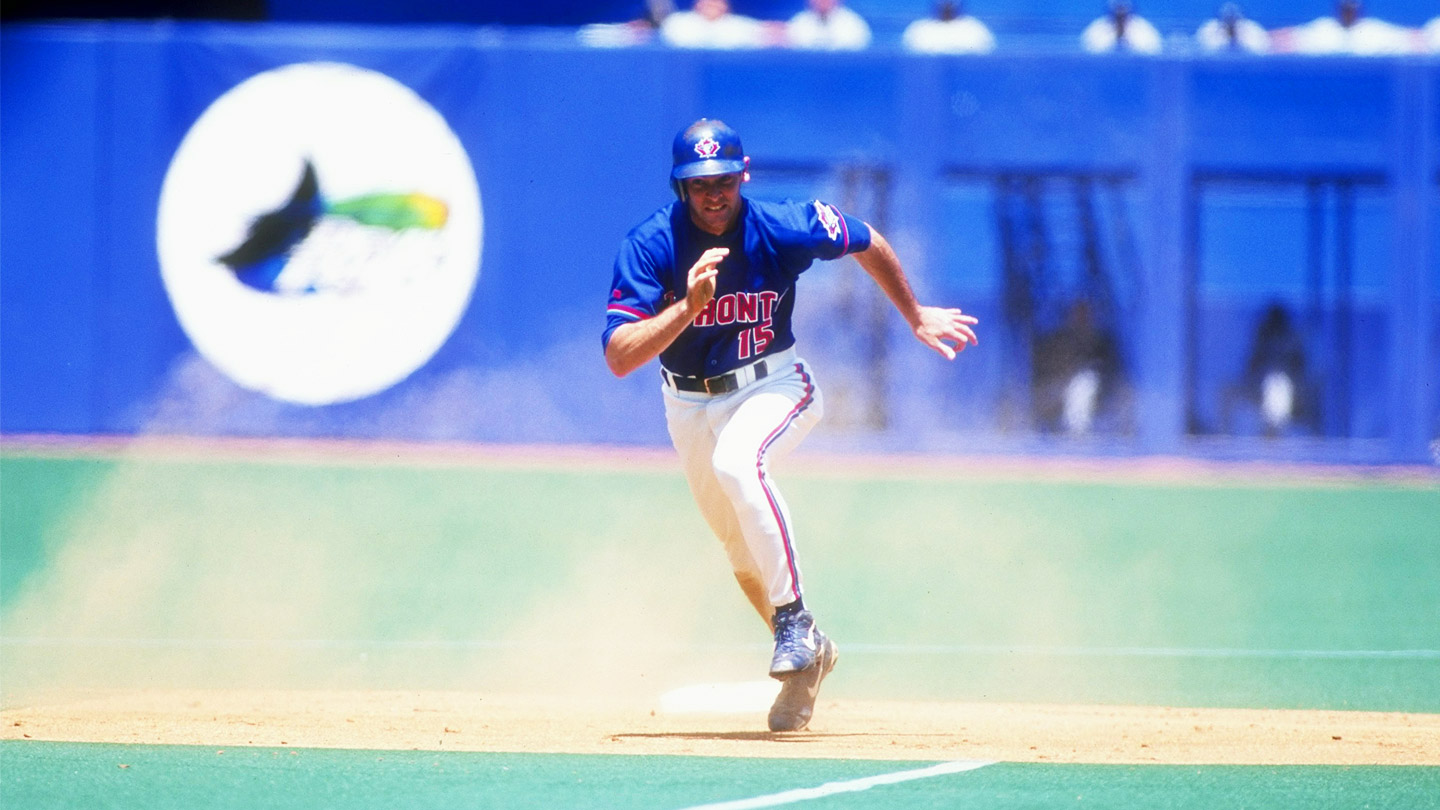So, before we get to the riot in Richmond Hill, a little background…
By the fall of 1992, Roberto Alomar was a sports hero the likes of which Toronto had not seen before.
Of course, the city had hosted more than its share of iconic athletes through the decades — Maple Leafs and Argonauts, and Blue Jays pretty much from the day the club arrived in 1977. There was always someone who was the biggest star in town.
But in the early ’90s, celebrity was taking on a different hue. Professional athletes, at least the most popular of them, were beginning to shed any qualifying adjectives. More like movie stars or musicians, they had started to inhabit a plane above and beyond the games they played.
Where does Roberto Alomar rank among the 40 greatest Blue Jays of all time? Have your say by clicking here.
Alomar arrived in Toronto in December 1990 as part of the biggest trade in the history of the Blue Jays, a deal with the San Diego Padres in which four all-stars changed uniforms in a single transaction — all but unheard of then, and all but impossible now. The Jays’ general manager, Pat Gillick, who had meticulously built the franchise from its expansion origins into a contender, was facing cynicism in the fan base, the product of too many near misses since the team’s first playoff appearance in 1985. It turned out that the group with Dave Stieb topping the rotation and George Bell in the heart of the order would never be quite good enough, always undone by one fatal flaw or another.
Meticulous and measured in his management style, Gillick was labeled “Stand Pat” by some because of his alleged reluctance to make the big move that would fix everything instantly and deliver a World Series to Toronto. But with that single, culture-changing transaction, the nickname disappeared forever. Gillick had taken an abrupt left turn away from his master plan, swapping prime-time talent for prime-time talent, upending the clubhouse balance, and rolling the dice.
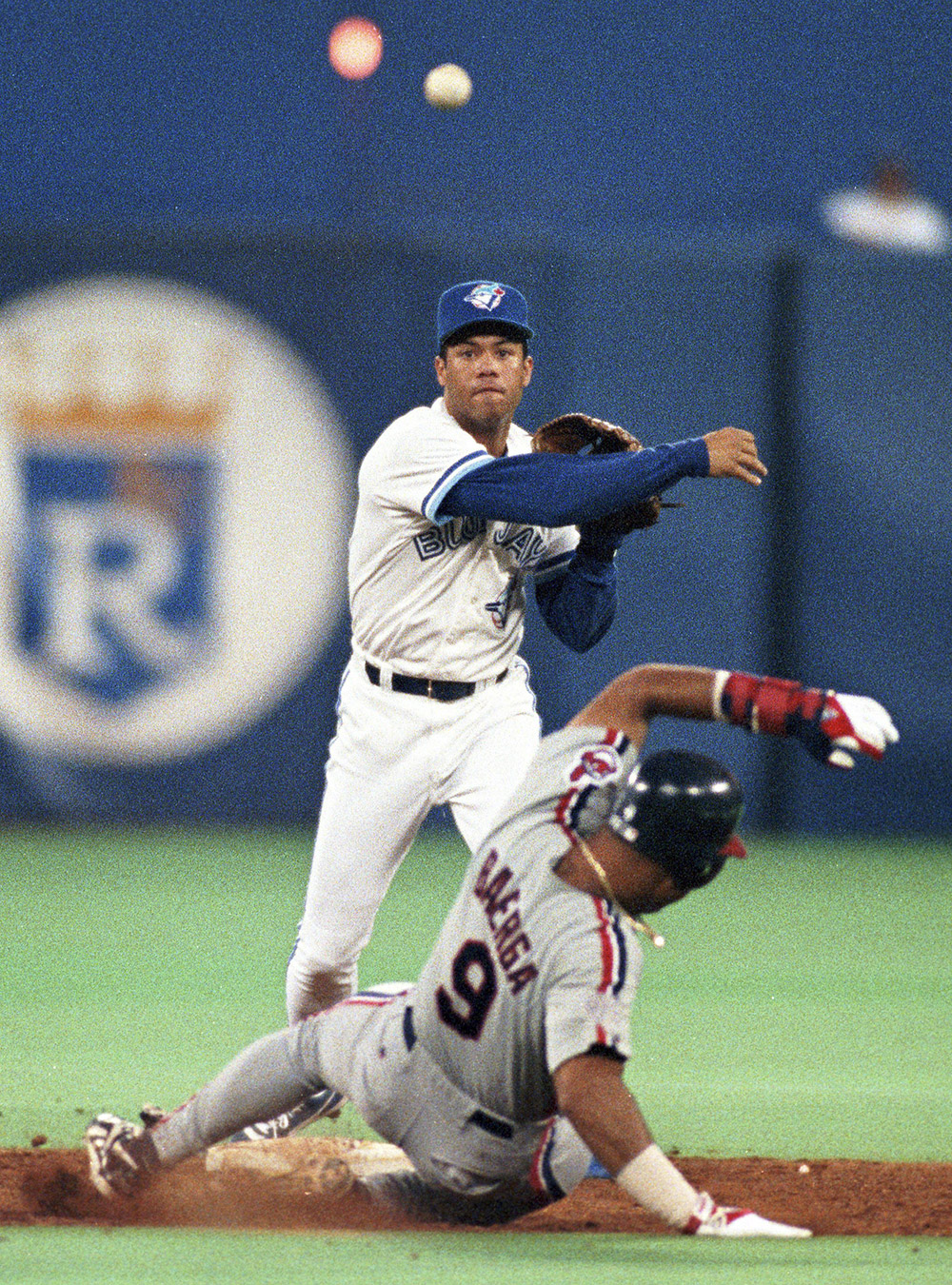
The truth is that for most Toronto fans, Alomar was the least of it. The Jays were surrendering two of their brightest young home-grown stars: power-hitting first baseman Fred McGriff and the sublime shortstop Tony Fernandez, both of whom would go on to long and productive careers that left them just a few steps short of the Hall of Fame. Coming back in return was Joe Carter, who, during his previous stints with the Cubs and Indians before winding up with the Padres for a year, had earned a reputation as one of the game’s most reliable sluggers and run producers, and a young middle infielder who had yet to live up to his blue-chip billing. If anything, Alomar’s stock had dropped over the previous couple of seasons, which included a shift from second base to shortstop that he resisted, and a contentious relationship with the Padres’ hard-ass manager, Greg Riddoch.
The Padres’ hierarchy had come to the conclusion that he was a malcontent, a pouter, a prima donna, and they were happy to take Fernandez, a complicated personality in his own right, as his de facto replacement. (In an interview during spring training following the trade, Fernandez, whose fervent faith made the rest of the born-again crowd in the clubhouse seem like Richard Dawkinses by comparison, said that God would surely take revenge on the Jays for dealing him away.)
There were baseball insiders, though, who maintained that Alomar was the real jewel in the trade, and almost from the first day he put on a Blue Jays uniform they were proven correct. He was happy to be out from under Riddoch’s thumb; happy with a fresh start; happy playing for an easy-going manager, Cito Gaston, who seemed to understand and appreciate him; happy living in a room in what was then the Skydome Hotel, a short elevator ride from the Jays’ clubhouse. Alomar had found a home, found security, and blossomed. His combination of all-world defensive skills at second base, an offensive repertoire that included hitting for average, hitting for power and prodigious base stealing, and a genius baseball IQ, was like nothing Jays fans had seen before. That first season in Toronto he returned to the All-Star Game, won his first of six consecutive Gold Gloves, and did the things that many believe made him the finest player in the franchise’s first 40 years.
Yes, there’s a legitimate debating point there. You can make a sound statistical argument that Alomar’s best seasons actually came after he left Toronto for Baltimore and then Cleveland, that a deeper dive into the numbers proves that there are others more deserving of being named the best Blue Jay of them all. No one is dismissing the value of baseball analytics here. They are revelatory, and they matter. But to these eyes — perhaps dulled a little bit by time and nostalgia, perhaps overly influenced by happy memories of those remarkable years — Roberto Alomar remains the most perfect ballplayer ever to call Toronto home.
Despite his strong debut, the Jays fell short in the first season after the big trade, losing to the eventual World Series-champion Minnesota Twins in the American League Championship Series, and some of the old doubts crept back into the conversation around the team — which only made what happened next that much sweeter. The 1992 season played out like a fairy tale, and the city, the country, fell in love. Alomar’s ninth-inning, game-tying, two-run home run off the previously untouchable Dennis Eckersley of the Oakland Athletics in Game 4 of the ALCS was a watershed moment for the franchise, erasing all of those near misses in a single stroke. After the A’s were dispatched, it was on to the World Series, where that final out in the 11th inning of game six, Mike Timlin fielding Otis Nixon’s bunt and throwing the ball to Carter at first, became a Canadian sports moment to rival all of those famous hockey goals.
Alomar was in many ways the face of that team — young and handsome with a megawatt smile, the star of television commercials for fruit drinks. And naturally there was a constituency within his enormous fan base for whom fielding range and on-base percentage were decidedly secondary attractions. Good-looking athletes have forever been swooned over, but this was of a different magnitude, at least for Toronto. This was Robbiemania.
As the Jays were beginning their march to that first championship, a visionary publisher and rabid baseball fan saw what was happening, saw the emergence of this crossover star and understood that there was commercial (if not purely literary…) potential in the Alomar phenomenon. She commissioned a rookie author to pen Alomar’s as-told-to autobiography, following in the line of similar books that had celebrated the careers of past Jays Dave Stieb, Ernie Whitt, Kelly Gruber and, remarkably, Rick Bosetti. The book was due to be delivered in time for pre-Christmas publication in 1992. The timing could not have been more ideal.
Except… well, no use causing embarrassment these many years later. Suffice it to say that following a series of the-dog-ate-my-homework exchanges, it became clear that there was no manuscript. The book had not actually been written. Considerable panic ensued.
Which is when a newspaper sports columnist with bills to pay got a phone call.
Second to None was completed in six weeks total — from first conversation to final edit. That’s not writing. That’s typing.
The process included a kind of speed-dating interview process and a quick, memorable trip to Puerto Rico to meet Alomar’s family. His father, Sandy Alomar Sr., left an especially strong impression, a man who had worked hard for his baseball career, had surmounted the many barriers placed in front of Latin American players of his generation, and whose views on the game, the business of the game, and the way of being a professional had become the gospel for his youngest son.
Many late nights later, something that at least looked book-like emerged. Going back and reading it now, it’s actually not half-bad, judged by the low-bar standards of the genre. Given the circumstances under which it was produced, it ought to be eligible for some kind of award — best biography completed in six weeks about a subject who hadn’t lived all that long and couldn’t really explain in words what made him special.
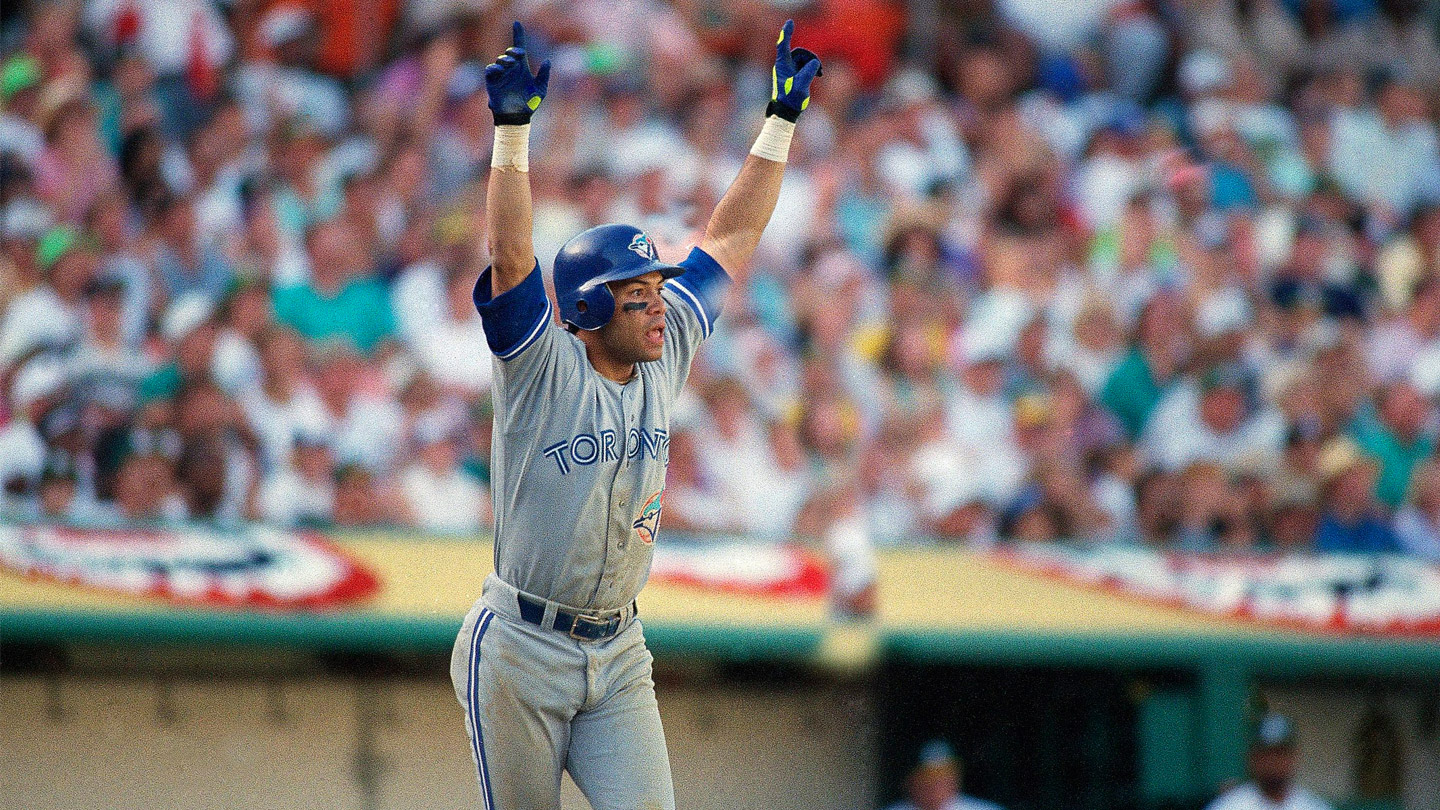
But whatever the book’s strengths or failings, the truth is they didn’t matter one bit. The whole reading part didn’t matter one bit. The vast majority of those who purchased Second to None, and then lined up for hours to secure Alomar’s signature in one of a handful of contractually mandated appearances in Toronto and nearby environs, weren’t looking for Roger Angell or Thomas Boswell. Had one tucked a $100 bill between pages 56 and 57 of one of those copies, it would likely still be there, untouched, on whatever dusty shelf it now resides.
What mattered was seeing Robbie, up close, in the flesh, being for a moment in his presence.
The signings were surreal affairs, mostly held in shopping malls. There was limousine service to loading-dock entryways so Alomar could sneak in unseen without causing a commotion before emerging to be instantly greeted by the sound of hundreds of screaming Robbie-ites. Sitting next to him was akin to invisibility — except for the occasional time when Alomar passed a book over for a second signature, and the happy purchaser suddenly recoiled in horror, shouting, “Why is he writing in my book!?”
Mothers pushed daughters forward. A wide variety of whispered propositions were made. Alomar would look over at his biographer and wink.
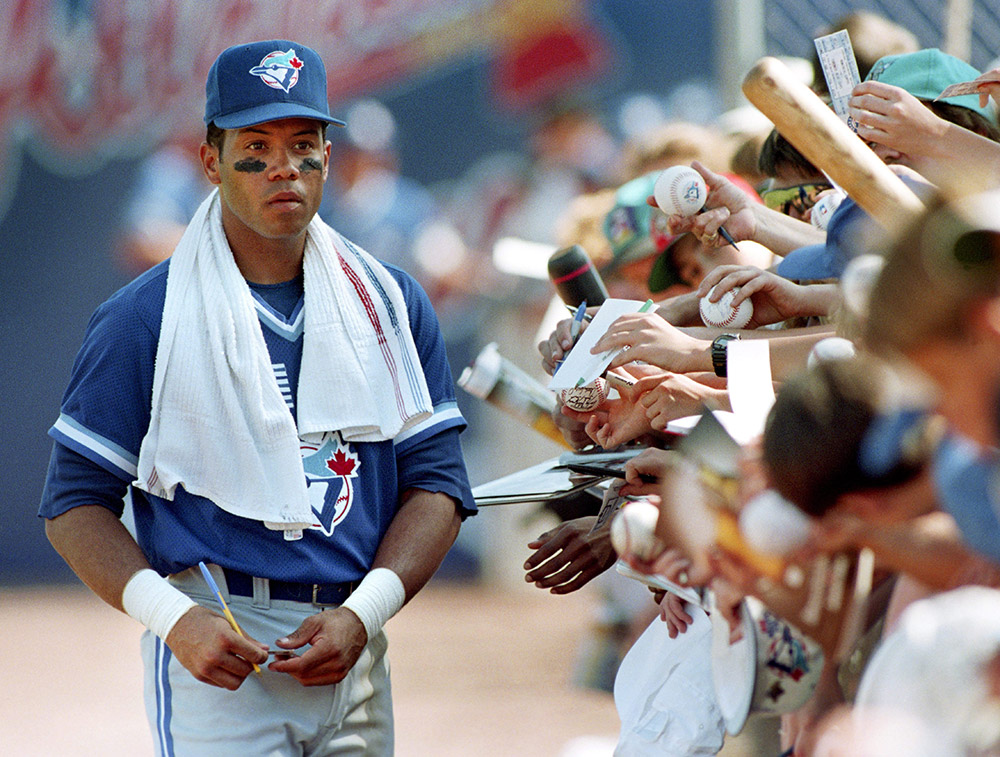
And then there was the day when it all boiled over, when the crowd at the Hillcrest Mall became so unruly that management panicked and abruptly brought down the metal barrier that they used to close the bookstore, leaving Alomar on one side of a cage and the teeming throng of his admirers on the other, desperately trying to break in. Apparently fearing looting and pillaging and mass disorder, the security guards then decided to clear the entire mall, bringing commerce temporarily to a halt.
“Now you understand my life,” Robbie said, exiting the chaotic scene in the limo. “No one understands, but now you, you understand what it’s like.”
Well, vicariously, voyeuristically, but not really.
A couple of years later, it was all over. The Jays of course won another World Series, this time with Alomar as the key cog in WAMCO. But when the winning ended in 1994 and 1995, management allowed him to leave after failing to come to terms on a new contract and then bad-mouthed him on the way out the door. They whispered that he had been a bad influence in the clubhouse. They’d find themselves another perfectly decent second baseman to replace him. (You can look it up — with a few, fleeting exceptions, they never have.) And yes, there was the John Hirschbeck spitting incident, right back in the Skydome, when Alomar was playing for his new team, the Orioles. Though the umpire and the player long ago mended fences, some Toronto fans weren’t ready to forgive and forget until Alomar got the call from Cooperstown and the Jays retired his number.
Who knew back in those heady days of ’92 and ’93 that it would be more than 20 years before the ball club would once more be so beloved, before there would be bat flips and walk-offs, a whole country hanging on every out, and other players who would become the toasts of the town?
But those Jays didn’t quite make it to the top. And they didn’t have a teen idol in their midst.





